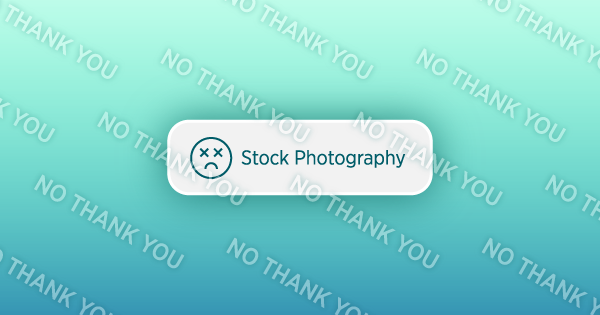For some designers, using stock imagery sourced from online marketplaces like Adobe Stock is like taking cough medicine—you know you need to use it, but it doesn’t mean you have to like it.
Since the early 2000s, when stock photography became widely accessible through the launch of online image marketplaces, professional designers have debated whether they should use it.
On one side are designers who say stock photography offers nothing but cheesy, inauthentic images that can never properly represent their product or company. They prefer custom photos featuring real employees, real customers and real products. They’ll even take their own photos around the office to get them.
On the other side are designers who think that wisely selecting stock imagery from an online marketplace is an easy and affordable way to meet most of their image needs. With the availability of vector graphics, stock marketplaces also provide a fast way to get illustrations and icons. This can be incredibly helpful in design environments with limited budgets and tight timelines. Stock marketplaces also offer stock video and audio, and they’ve improved their libraries with “signature” collections that have photos with higher production value and better content.
Considering the online stock image market is a $3 billion business, our guess is many designers come down on the “easy and affordable” side of the debate. Whether they do it with a smile or a frown, we’re not sure. It is just an unfortunate fact that many designers work in organizations that can’t afford custom photo shoots.
So, if you need to find stock imagery, which marketplace should you use?
Shutterstock, Getty Images, iStock and Adobe Stock are some of the most recognized names in the stock image market. They all have advantages and drawbacks. Adobe Stock, however, the most recent paid platform to launch, is an option worth seriously considering.
Adobe Stock offers the right balance of convenience and cost when compared with other options. Its tight integration with the Adobe Creative Cloud (CC) platform sets it apart from other marketplaces. Stock’s benefits include:
- Ease of use (ability to work from within one application)
- Competitive cost
- Ability to buy single images
- A simple pricing model
The value of Stock’s integration with Adobe creative tools that designers use constantly outweighs its smaller image library and its lack of audio. According to a study commissioned by Adobe, Stock’s integrated workflow reduces the time involved in licensing an image from 3 minutes to 16 seconds. Since 85% of creatives who buy stock imagery use Adobe software to manipulate and place it, if you haven’t tried Stock yet, you should.
Users can search Stock from within Adobe CC software like Photoshop, Illustrator, and InDesign and save images to their CC Library. One of Stock’s neatest features is a preview mode that lets users add effects and tweaks to a low-res version of an image. The preview version is replaced with a high-res version and all effects are reapplied automatically when the image is purchased.
In June 2016, Adobe launched an upgrade to the Stock platform as part of its CC update, deepening its integration with CC tools. Stock now has a workflow that lets you select and place an image in your work with one click. The update also introduced the industry’s only one-click purchase capability.
In addition, Adobe added a Premium collection to Stock, a set of 100,000 hand-selected images sourced from some of the world’s leading photographers. They provide exceptional content, style and production quality.
If the rationale for relying on stock imagery is its ease of use and affordability, then the same rationale can apply when selecting a marketplace. Other platforms have been around longer and may offer wider selections, but Adobe Stock is the easiest to use and one of the most affordable options out there.



Leave a Reply